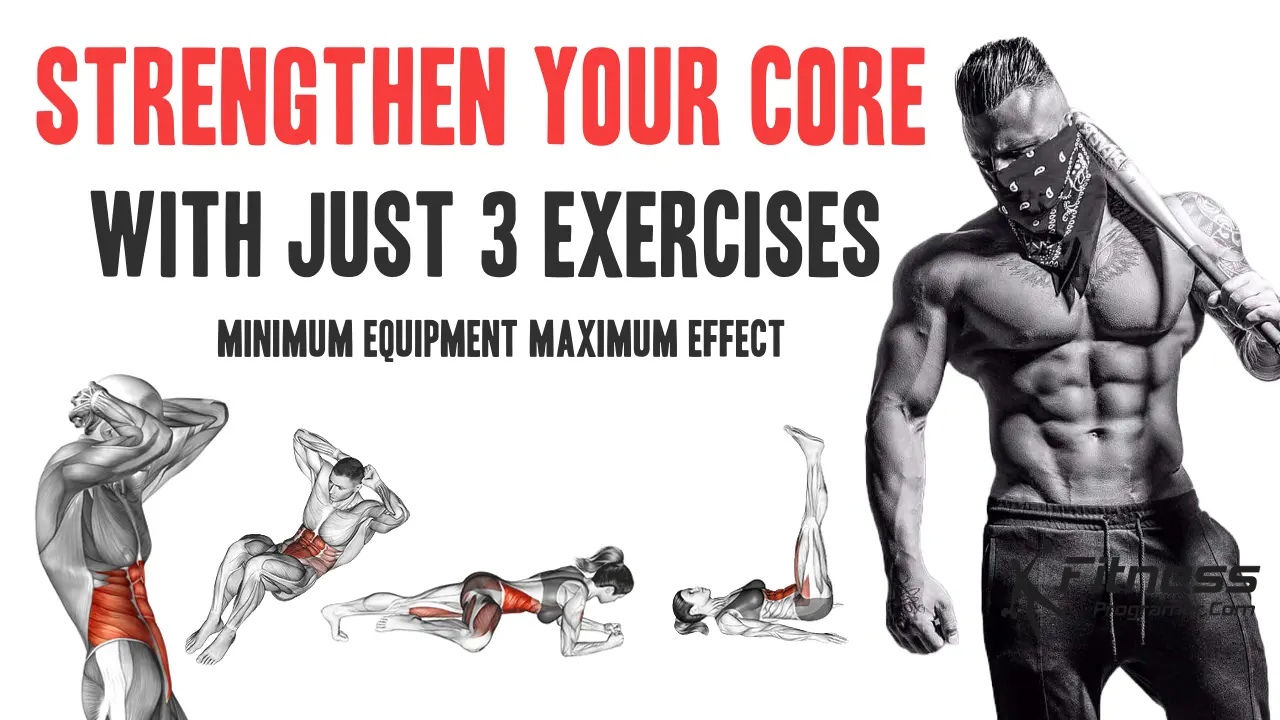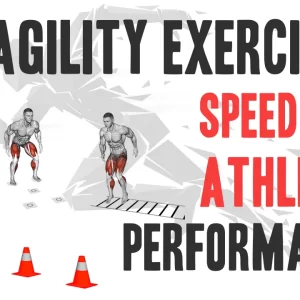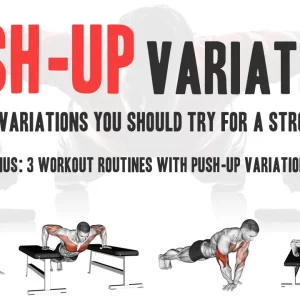A strong and stable core is the cornerstone of a healthy and functional body. Beyond its role in achieving that coveted six-pack, a robust core is vital for supporting daily activities, maintaining proper posture, and excelling in athletic pursuits. The best part? You don’t need a fully equipped gym or specialized equipment to attain a powerful core. In this guide, we’ll show you how to strengthen your core effectively with just three simple yet highly impactful exercises.
Why Strengthen Your Core?
It’s not just about sculpting an appealing midsection; it’s about building a foundation that supports your daily activities, improves posture, and enhances your athletic performance. Let’s dive into the compelling reasons why you should prioritize core strength:
1. Core Muscles Are Used in Everyday Activities
Think about your daily routine. Whether it’s carrying groceries, lifting boxes, or simply bending down to tie your shoes, you engage your core muscles. These muscles support your spine and help stabilize your body during various movements. Maintaining a strong core can significantly reduce the risk of lower back pain and discomfort caused by everyday activities.
The Core in Action
1. Carrying Groceries: Have you ever lugged a bag of groceries from the store to your car and then into your home? Your core muscles are actively engaged in maintaining your posture and stability as you distribute the weight of those bags. Without a strong core, you might find yourself straining your back or relying more on your arms, which can lead to overuse injuries.
2. Lifting Boxes: Whether you’re moving house or just rearranging furniture, lifting boxes is a common activity. Your core muscles provide the necessary support to your spine and help you maintain proper body mechanics during these movements. Weak core muscles can increase the risk of back injuries or strain.
3. Bending Down to Tie Your Shoes: Even the simplest tasks, like tying your shoes, require core engagement. As you bend forward, your core muscles help stabilize your spine, preventing excessive flexion and maintaining balance. A strong core makes this seemingly effortless action truly effortless.
The Role of Core Strength in Pain Prevention
One of the most compelling reasons to strengthen your core is its role in preventing lower back pain and discomfort. When your core muscles are weak, they can’t effectively support your spine during these routine activities, which can lead to excessive stress on the lower back. Over time, this stress can result in chronic pain and even more serious back problems.
By actively strengthening your core through targeted exercises, you can provide the stability and support your spine needs. This, in turn, reduces the risk of injury and discomfort during everyday tasks. It’s not just about looking good; it’s about feeling good and maintaining a high quality of life.
2. Your Core Affects Your Balance and Posture
Your core is like the central pillar of your body: rectus abdominis, obliques, transverse abdominis, and erector spinae. These muscles work together to maintain balance and good posture. Weak core muscles can lead to slouching and poor alignment, which can contribute to chronic pain and injury over time.
The Core’s Role in Balance and Posture
1. Balance: Your core muscles are responsible for keeping you upright and steady. They act as the body’s internal stabilizers, helping you maintain equilibrium during various movements. Whether you’re standing on one leg or walking on uneven terrain, your core muscles are hard at work to keep you from falling.
2. Posture: Good posture is not just about looking confident; it’s about aligning your body in a way that minimizes stress on your muscles, bones, and ligaments. Your core muscles work in harmony to support your spine and maintain proper alignment of your head, shoulders, and pelvis. Weak core muscles can lead to slouching, rounded shoulders, and an arched lower back, all of which can result in chronic pain and discomfort.
The Consequences of Weak Core Muscles
When your core muscles are weak, your body compensates by overloading other muscle groups, leading to imbalances. These imbalances can cause a cascade of problems, including:
- Chronic Pain: Poor posture and muscle imbalances can lead to chronic neck, shoulder, and back pain. Over time, this discomfort can become debilitating and affect your overall quality of life.
- Injury Risk: Weak core muscles increase the risk of injury during physical activities. You’re more susceptible to strains, sprains, and even more severe injuries, especially if your core can’t support your body’s movements properly.
- Reduced Mobility: Limited core strength can limit your range of motion and flexibility, making it difficult to perform everyday tasks and enjoy physical activities to their fullest.
Strengthening Your Core
The good news is that you can address these issues by actively working to strengthen your core muscles. Core-specific exercises like planks, bridges, and leg raises can target these muscle groups effectively. Incorporating yoga or Pilates into your fitness routine can also help improve core strength and flexibility.
By strengthening your core, you’ll not only enhance your balance and posture but also reduce the risk of chronic pain and injuries. Plus, you’ll feel more confident, move more effortlessly, and enjoy an overall improved quality of life.
3. Better Athletic Performance
Athletes, both amateur and professional, understand the significance of core strength. Many sports require a high level of muscle strength and coordination. For example, in basketball, a strong core contributes to better stability and balance, allowing you to change direction quickly, jump higher for rebounds, and maintain control during fast breaks. It also helps with shooting accuracy by providing a stable platform for your upper body while shooting.
The Core’s Role in Enhancing Workouts
1. Stability: Your core muscles, including the rectus abdominis, obliques, transverse abdominis, and erector spinae, act as stabilizers for your entire body. When you engage in exercises that target your arms, chest, or shoulders, your core provides the necessary stability to maintain proper form and balance. This stability ensures that you can lift heavier weights, perform more reps, and reduce the risk of injury during these exercises.
2. Form: Proper form is crucial for effective workouts and injury prevention. A strong core helps you maintain good posture and alignment while exercising. For example, during a bench press, your core muscles stabilize your spine, allowing you to push the weight with precision and power. Without a strong core, you might arch your back, risking strain and poor form.
3. Power Transfer: Many exercises involve movements that require power transfer from your lower body to your upper body or vice versa. For instance, when performing a squat, your core plays a vital role in transferring force from your legs to your upper body, allowing you to lift heavier weights and develop stronger leg and core muscles simultaneously.
Reducing the Risk of Injury
Beyond enhancing performance, a strong core also plays a crucial role in injury prevention. Many sports involve dynamic movements and sudden changes in direction, which can put stress on the musculoskeletal system. A robust core provides stability to your spine and reduces the risk of overuse injuries and strains, allowing you to train and compete more consistently.
The Benefits of a Strong Core for Overall Strength and Endurance
A strong core acts as a solid foundation upon which to build your strength and endurance. Here’s how it benefits your overall fitness:
- Increased Strength: When your core is strong, you can generate more force during exercises, allowing you to lift heavier weights and build muscle more efficiently. This translates to increased strength not only in your core but also in the muscle groups you’re targeting.
- Enhanced Endurance: As your core provides stability and support, you can perform exercises with better form for longer durations. This improved endurance means you can push through more challenging workouts, leading to better results over time.
- Injury Prevention: A strong core reduces the risk of injury during workouts. When your body is properly aligned and stable, you’re less likely to strain or overuse specific muscle groups, joints, or ligaments.
Incorporating Core Training into Your Athletic Routine
To reap the benefits of a strong core in your chosen sport, it’s essential to incorporate core-specific exercises into your training regimen. This can include exercises like planks, Russian twists, medicine ball throws, and leg raises. Yoga and Pilates are also excellent choices for improving core strength and flexibility.
Strengthen Your Core with Just 3 Exercises
The beauty of core exercises is their simplicity and convenience. You can incorporate them into your daily routine without needing to set aside a specific time or travel to a gym. Now, let’s explore three core exercises that require minimal equipment and offer exceptional results:
- Frequency: Starting with 2-3 days a week is a reasonable goal.
- Sets: You can perform 2 to 4 sets per exercise.
- Reps: Opt for higher repetitions, typically between 15 to 20 reps per set.
- Rest Between Sets: Allow adequate rest between sets, typically 30 seconds to 1 minute, depending on your fitness level and the intensity of the exercise.
- Set Achievable Goals: Set specific, achievable goals for your core strength and endurance. For example, aim to hold a plank for 30 seconds longer than your previous best or increase the number of repetitions in your crunches.
- Combine with Other Exercises: Incorporating core exercises into your broader workout routine can be both time-efficient and effective. (Here are the 15 Best Equipment-Free Full-Body Exercises You Can Do at Home)
- Warm-Up and Cool-Down: Always include a brief warm-up to prepare your muscles and joints, and finish your core workouts with a cooldown and stretching to promote flexibility and reduce muscle soreness.
Exercise 1: Crunches
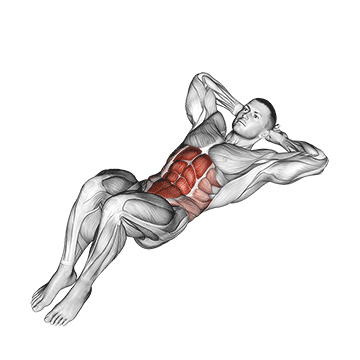
Crunches are a fundamental core exercise that targets the rectus abdominis, the prominent muscle group often referred to as the “six-pack.” When performed correctly, crunches can help you develop a strong and toned midsection. Here’s how to perform them:
- Lie on your back with your knees bent and feet flat on the floor.
- Place your hands lightly behind your head or across your chest.
- Engage your core muscles by pulling your navel toward your spine.
- Lift your head, neck, and shoulders off the ground by contracting your abdominal muscles.
- Exhale as you crunch upward, focusing on contracting your abs.
- Inhale as you lower yourself back down to the starting position.
Crunches: Muscles Activation
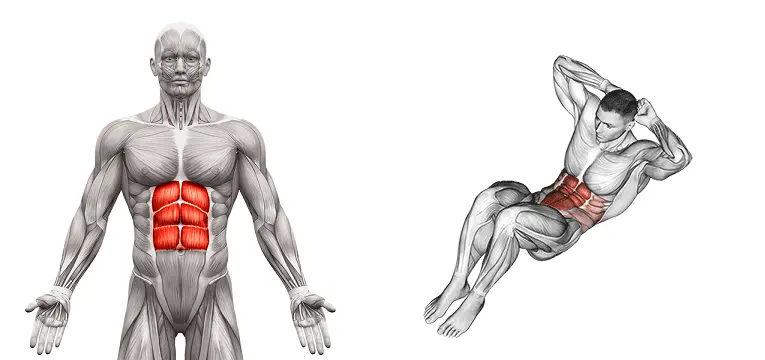
This muscle runs vertically down the front of your abdomen, and when you perform crunches, it contracts to help you lift your upper body off the ground. Crunches target the upper portion of the rectus abdominis, which is responsible for flexing the spine, bringing your chest closer to your hips.
To add variety to your routine, consider incorporating the following variations:
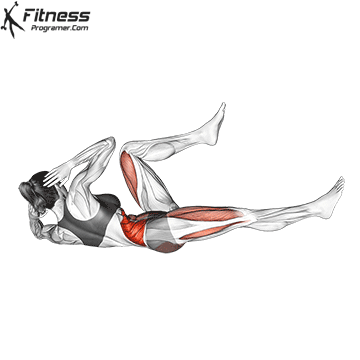
Bicycle Crunches: While performing crunches, bring your right elbow to your left knee as you simultaneously extend your right leg straight. Alternate sides in a pedaling motion.
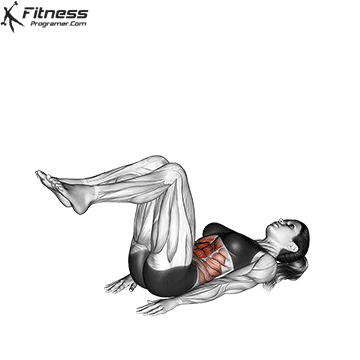
Reverse Crunches: Lie on your back, place your hands by your sides, and lift your legs while bending your knees at a 90-degree angle. Contract your lower abs to lift your hips off the ground.
Exercise 2: Leg Raises
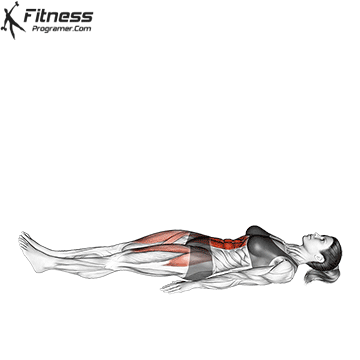
Leg raises are fantastic for targeting the often-neglected lower abdominal muscles. Here’s how to perform them:
- Lie flat on your back with your arms by your sides and your legs extended.
- Engage your core muscles by pressing your lower back into the floor.
- Lift your legs off the ground, keeping them straight and together, until they are perpendicular to the floor.
- Lower your legs back down slowly, ensuring that your lower back remains in contact with the floor.
- Exhale as you lift your legs, and inhale as you lower them.
Leg Raise: Muscle Activation

Leg raises primarily activate the lower abdominal muscles, specifically the lower portion of the rectus abdominis. When you perform leg raises, your lower abdominal muscles contract to lift your legs off the ground or an elevated surface. This exercise places a significant emphasis on the lower part of the rectus abdominis, helping to tone and strengthen that region.
In addition to the lower abdominal muscles, leg raises also engage the hip flexors, which are located at the front of your hips and play a crucial role in lifting your legs. The hip flexors work in conjunction with the lower abs to perform leg raises effectively.
It’s worth noting that while leg raises primarily target the lower abs, they also require stability from your entire core to maintain proper form and prevent excessive arching of the lower back. Therefore, leg raises are considered an effective exercise for developing both lower abdominal strength and overall core stability.
To increase the difficulty of leg raises as you progress:
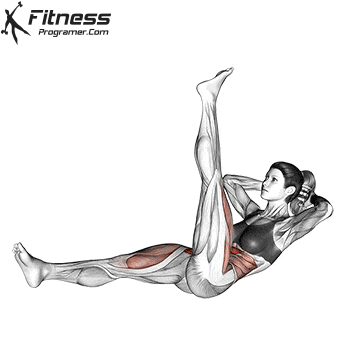
Alternate leg raise: Instead of lifting both legs at a time, lift both legs one by one to work your lower abdominal muscles more intensely.
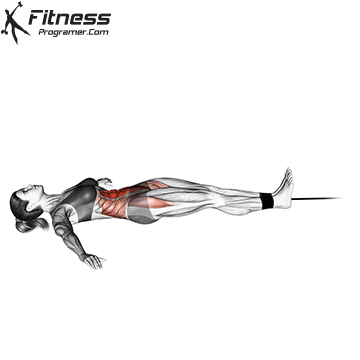
Add Ankle Weights: Gradually incorporate ankle weights to make the exercise more challenging and further strengthen your lower core.
Exercise 3: Spider Planks
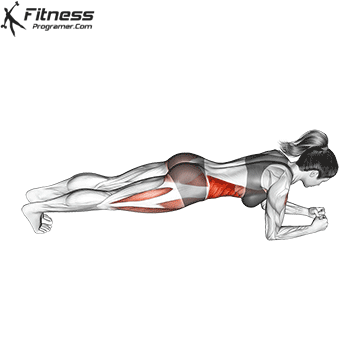
Spider planks are a dynamic variation of the classic plank exercise that not only engage your core but also work your oblique muscles and improve hip flexibility. This exercise challenges your balance and stability while targeting different areas of your core. Let’s break down how to perform spider planks correctly:
- Begin in a push-up position with your hands directly under your shoulders and your body in a straight line from head to heels.
- Engage your core muscles to maintain a straight and stable posture.
- Lift your right foot off the ground and bring your right knee toward your right elbow in a controlled manner.
- Hold for a moment, then return your right foot to the starting position.
- Repeat on the left side, bringing your left knee toward your left elbow.
- Alternate between right and left knees in a controlled and deliberate manner.
Spider Plank: Muscle Activation
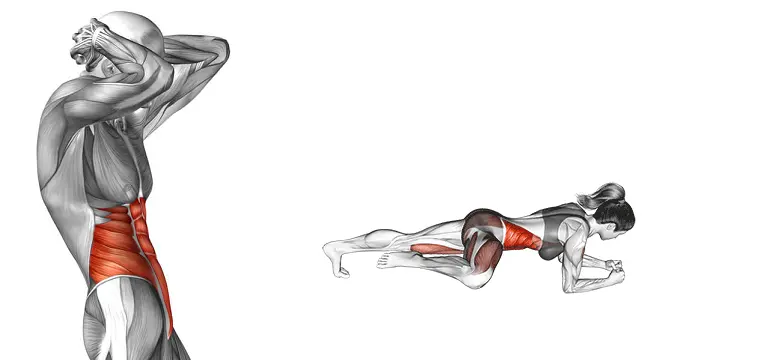
Spider planks are a comprehensive exercise that engages various muscle groups throughout your core, including the front, sides, and deep muscles. Additionally, they involve muscles in your upper and lower body to maintain the plank position and control the leg movement. This exercise not only strengthens your core but also enhances overall body stability and coordination.
Conclusion
Strengthening your core doesn’t have to be complex or require expensive equipment. With just three simple yet highly effective exercises—crunches, leg raises, and spider planks—you can build a robust core that enhances your daily life, maintains your posture, and boosts your athletic performance.
Incorporate these exercises into your fitness routine, gradually increase their intensity, and watch as your core becomes a source of power and resilience. Consistency is key, so start today, and enjoy the myriad benefits of a strong core for a healthier, more active life. The journey to a stronger core begins with these three exercises and your determination to succeed.

